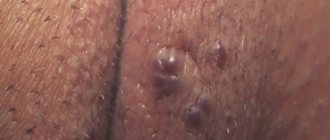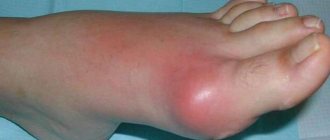A rash or rash is usually called any change in the skin or visible mucous membranes. The nature of rashes in men can be extremely varied. They can be represented by spots, blisters, blisters, nodules, peeling, erosions and even ulcers. Sometimes the same elements of the rash can be a manifestation of the disease, and in other cases a variant of the norm. The rash may be accompanied by various kinds of subjective sensations (itching, burning, pain). Rashes in the genital area in men are quite common. Among the main reasons that can lead to the appearance of rashes in the genital area in men, bacterial and viral infections, exacerbation of chronic dermatoses, the allergic nature of the rash and oncological processes should be noted. Rashes differ in volume, color, size, location, as well as in the nature of subjective sensations. Even an experienced doctor cannot always immediately make a diagnosis based on the nature of the rash. Often enough to establish the nature of the rash, i.e. Clinical diagnosis requires careful examination.
Particular attention should be paid if the rash: 1) exists for more than 1-2 weeks without changes; 2) accompanied by severe itching and swelling of the genital organs; 3) have the appearance of outlined reddish spots with slight peeling on the surface; 4) presented in the form of bubbles filled with clear, cloudy or bloody liquid; 5) appeared within several weeks after unprotected sexual intercourse; 6) accompanied by an increase in temperature or enlargement of the inguinal lymph nodes; 7) look like a completely painless ulcer; Fresh rashes form that do not go away on their own.
2) accompanied by severe itching and swelling of the genital organs; 3) have the appearance of outlined reddish spots with slight peeling on the surface; 4) presented in the form of bubbles filled with clear, cloudy or bloody liquid; 5) appeared within several weeks after unprotected sexual intercourse; 6) accompanied by an increase in temperature or enlargement of the inguinal lymph nodes; 7) look like a completely painless ulcer; Fresh rashes form that do not go away on their own.
Rashes due to bacterial and viral infections
Rash in the anogenital area in men can occur with a number of bacterial or viral infections, as well as with scabies or lice. The most common causes leading to the appearance of various rashes include syphilis, Reiter's syndrome, herpes simplex, human papillomavirus infection, candidiasis and other fungal pathogens, as well as molluscum contagiosum and scabies. Rashes can be similar for different reasons that led to their appearance, which significantly complicates diagnosis. Most often, rashes of an infectious nature manifest themselves as spots, nodules, blisters, erosions and ulcers. Depending on the type of rash, the nature of the disease can be assumed.
So, with syphilis, the nature of the rash can be very diverse. The rashes can be represented by small papules, erosions and even ulcers, depending on the stage of the disease. A distinctive feature of syphilis rashes is the absence of subjective sensations. With Reiter's syndrome (chronic chlamydia, the process is usually represented by flat nodules that can merge with each other, and can also be covered with mealy scales. Herpes simplex is usually characterized by typical rashes: grouped blisters with serous contents on a slightly edematous-hyperemic background. Anogenital warts: The main element of this contagious dermatosis is pointed papules.Sometimes they merge into large formations that resemble “cauliflower”.
With mitotic lesions of the skin and mucous membranes of the anogenital area, reddish spots of various sizes usually appear, which are accompanied by fairly intense itching. Molluscum contagiosum or viral dermatosis is manifested by flat or hemispherical nodules, inside of which there is a crumbly mass of whitish-yellowish color. Quite often, papules have an umbilical depression in the center. With parasitic dermatosis (scabies), the rash is caused by the activity of the scabies mite and has the appearance of characteristic burrows. The tick's entrance is represented by small dots, and as it moves, small bubbles appear in the skin. Nighttime itching is very typical.
Where to go with a rash on the foreskin
Our clinic employs an experienced dermatologist who is ready to see a patient with characteristic symptoms on the same day of treatment. At the appointment, anamnesis will be collected, a visual examination will be carried out, a preliminary diagnosis will be made and a referral will be issued for further laboratory and instrumental tests, if required.
You can make an appointment in one of the following ways:
- call the specified number with a brief description of the reason for contacting and disturbing symptoms;
- fill out an electronic form on the clinic’s website, specifying which doctor you need to visit and indicating a telephone number for feedback in order to confirm the application and agree on the most convenient time to visit the doctor;
- independent visit to the clinic and registration at the reception.
Choosing any method of making an appointment with a dermatologist involves providing certain personal information. All transmitted personal information, at the request of the patient, can be kept confidential, and the treatment will be completely anonymous.
Rashes due to allergic reactions and exacerbation of chronic dermatoses
Rashes in the genital area can be a manifestation of allergic reactions - allergic dermatitis, fixed toxicoderma, and also occur during exacerbation of a number of chronic dermatoses - psoriasis and lichen planus. Often, manifestations of vitiligo can be observed in the anogenital area. The types of rash in these cases are extremely variable - spots, papules, blisters and blisters. Rashes with allergic dermatitis are polymorphic. Depending on the duration of the process, red spots, swelling, blisters and microerosions may be observed. As the process subsides, peeling forms. All elements are accompanied by constant itching. Fixed toxicoderma is a variant manifestation of a drug disease with intolerance to certain drugs. Quite large blisters with serous contents are formed, after opening which large erosion occurs. Psoriasis and lichen planus are accompanied by the formation of nodules of various sizes with peeling on the surface. Typically, the appearance of a rash in the anogenital area occurs simultaneously with the appearance of rashes on other areas of the skin. Almost always there is itching of varying degrees of intensity. Vitiligo is a disease associated with the loss of melanin pigment by skin cells, resulting in the formation of whitish spots of various sizes and configurations.
Herpes and papillomavirus
It is quite important to note the possible causes of a rash on the foreskin. The main reasons include:
- Herpes.
- Papillomavirus.
- Fungus
- Allergies.
When a rash on the foreskin turns out to be caused by genital herpes, it most likely happens through sexual contact with a carrier of this disease. Moreover, herpes only needs to appear in epithelial cells once, and it remains there until the end of life, exacerbating periodically.
Along with the rash, swelling and redness appear. Bubbles may appear, the contents of which are transparent. Then they burst and form small ulcers. When the ulcers disappear, no traces remain, but a certain time passes and an exacerbation occurs again. Herpes also happens due to the deterioration of human immunity.
As for human papillomavirus infection, it can also be transmitted through sexual contact and has a direct connection with deteriorated human immunity. The manifestation of such an infection is possible in the form of genital warts, which are located on the skin. These condylomas are the same color as the skin. At first, the growths may be single, but then their total number begins to increase.
If we talk about removing condylomas, we often have to resort to a surgical method. It is necessary to do this on time, one way or another, before they connect with each other, forming conglomerates that are difficult to cure and cause serious discomfort. In addition, such formations are fraught with the risk of cancer.
Common symptoms and manipulations in dermatology:
- Skin rashes
- Calling a dermatologist to your home
- Itching in the urethra
- Itchy skin
- Skin rash
- Prevention of casual sex
- Skin neoplasms
- Pyoderma
- Pityriasis rosea
- Streptoderma
- Scabies
- Peeling skin
- Fungal infections
- Skin infection
- Pus on the skin
- Blisters on the skin
- Papillomas on the foreskin
- Sexually transmitted diseases
- Skin structure
Rashes due to cancer processes
Rare, but extremely dangerous, are rashes as manifestations of oncological processes, including malignant neoplasms. Rashes can vary from macules, papules, to ulcerative elements. Queyra's syndrome is a precancerous disease characterized by the appearance of persistent edematous hyperemia of the glans penis. Subjective sensations are usually absent. Melanoma is an extremely dangerous disease that appears as spots of deep brown or black color. Squamous cell carcinoma manifests itself as painless erosions on the skin, prone to peripheral growth and fusion.
General signs of a possible oncological process: – long-term non-healing erosions or ulcers; – deformation of the genital organs; – appearance and rapid growth of pigment spots.
Treatment of rash on the foreskin
The determination of treatment methods for pathological rashes on the foreskin is based on the results of the initial examination, laboratory tests, analyzes and hardware diagnostics.
The following methods of treating diseases not associated with allergic manifestations are distinguished:
- purulent acne is treated with antiseptic agents, followed by proper hygiene of the genital organs;
- if the infectious nature of acne is detected, surgical treatment is prescribed by removing or cauterizing genital warts;
- manifestations of herpes are treated with an ointment with an antiviral effect; in acute or chronic forms of the disease, special medications are prescribed for oral administration;
- Therapy for rashes caused by microscopic parasites is based on careful adherence to hygiene measures and the use of local remedies.
Painless pimples caused by blockage of the sebaceous glands can be eliminated through careful care of the intimate area. It is recommended to take regular showers without necessarily using soap and other household chemicals.
Rashes as normal variants
Often, some completely normal formations (for example, sebaceous glands), which are present on the skin of the genital organs of all healthy people, are mistaken for pathological rashes in the anogenital area. The skin of the penis is very thin, delicate and elastic and is equipped with a large number of large sebaceous glands. The final development of the sebaceous glands on the skin of the penis coincides with the period of puberty and it is at this time that young men may be very concerned about the appearance of a profuse white rash on the penis. Large sebaceous glands on the skin of the penis (Fordyce granules) look like whitish compactions with a diameter of several millimeters, located in the thickness of the skin of the penis.
The sebaceous glands on the skin of the penis are especially noticeable if the skin of the penis is stretched. Also, during puberty in men, a special group of glands is formed located along the edge of the head of the penis. These glands (pearl glands) have the appearance of small pointed projections, are pale pink in color and together give the extreme line of the glans penis a slightly jagged appearance. In some cases, the sebaceous glands on the skin of the penis or the skin of the labia majora may become inflamed. Inflamed sebaceous glands greatly increase in size, become very painful and lead to severe swelling of the surrounding skin. In these cases, you should consult a doctor to prescribe treatment.
Reference and information material
Author of the article
Khaldin Alexey Anatolievich
Dermatovenerologist, clinical immunologist, MD, professor
Loading...
Take other surveys
Which doctor treats a rash on the foreskin
A dermatologist deals with the prevention and diagnosis of diseases that provoke the formation of rashes of various types, localized on the foreskin. The doctor’s responsibilities include collecting anamnesis and an initial visual examination of the affected areas, in order to determine further research activities or referral to more specialized specialists.
Ignoring a pathological condition with rashes on the foreskin can lead to chronic forms of disease and serious complications. Our clinic employs doctors with extensive practical experience in various branches of dermatology and urology, who are able to accurately diagnose the cause of the rash and create a suitable therapeutic course based on the patient’s individual characteristics.
Answers to frequently asked questions about skin rashes:
- Which doctor should you contact for a skin rash?
- Is the skin rash contagious?
- What diet is necessary for skin rashes?
- What diagnosis is needed for a skin rash?
- Why is a skin rash dangerous?
- Why is it necessary to get tested for a skin rash?
- What diseases does a skin rash indicate?
- What examination is necessary for a skin rash?
- Which skin rash is dangerous?
- How to distinguish an allergic rash from an infectious one
- How to get rid of skin rashes?
- How to get rid of itching skin rash?
- What organs are affected by a skin rash?
- How to prepare for an appointment with a dermatologist?
- How to get checked for skin diseases?
- What diseases does a dermatologist treat?
- What tests should be taken by a dermatologist?
- What diagnostics can a dermatologist perform in the clinic?
- Where to go with a skin disease?
Preventing rashes on the foreskin
The best way to deal with rashes on the foreskin is to prevent them. There are a number of general tips, adherence to which can significantly reduce the risk of the formation of such a pathological condition:
- carry out regular toileting of the genitals;
- change underwear daily;
- for hygiene procedures, use purely personal products and items, such as a towel, sponge, shaving accessories and others;
- avoid casual sex with untested partners;
- during sexual contact, use contraception that can prevent sexually transmitted infections;
- strengthen the immune system by taking special vitamin preparations.
If the characteristic symptoms of a rash in the groin appear, an immediate visit to our clinic is required in order to diagnose the pathogen.
Perhaps this is a simple allergic reaction and worries are in vain, but sometimes acne and other rashes can indicate a serious pathology. In such situations, therapy at the initial stages of development minimizes the risks of complications.
Publication date: 2019-12-11
Methods for diagnosing skin diseases:
- Diagnosis of skin diseases
- Diagnosis of skin diseases at home
- Diagnosis of allergic skin diseases
- Diagnosis of bacterial skin diseases
- Diagnosis of viral skin diseases
- Diagnosis of hair diseases
- Diagnosis of nail diseases
- Diagnosis of skin tumors
- Skin scraping
- Blisters on the skin
- Dermatoscopy
- Demodex tests
- Diagnosis of sexually transmitted infections
- Mushroom tests
- Skin scraping











